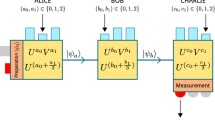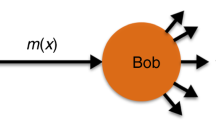Abstract
Most proposals for quantum solutions of information-theoretic problems rely on the usage of multi-partite entangled states which are still difficult to produce experimentally with current state-of-the-art technology. Here, we analyze a scheme to simplify a particular kind of multiparty communication protocols for the experiment. We prove that the fidelity of two communication complexity protocols, allowing for an N − 1 bit communication, can be exponentially improved by N − 1 (unentangled) qubit communication. Taking into account, for a fair comparison, all inefficiencies of state-of-the-art set-up, the experimental implementation for N = 5 outperforms the best classical protocol, making it the candidate for multi-party quantum communication applications.


Similar content being viewed by others
References
Bennett CH, Brassard G (1984) Quantum cryptography: public key distribution and coin tossing. In: Proceedings of IEEE International conference on computers, systems and signal processing. IEEE, New York, p 175–179
Brukner Č, Żukowski M, Pan J-W, Zeilinger A (2004) Bell’s inequalities and quantum communication complexity. Phys Rev Lett 92:127901
Brukner Č, Żukowski M, Zeilinger A (2002) Quantum communication complexity protocol with two entangled qutrits. Phys Rev Lett 89:197901
Buhrman H, Cleve R, van Dam W (2001) Quantum entanglement and communication complexity. Siam J Comput 30:1829–1841; [e-print: quant-ph/9705033]
Buhrman H, Cleve R, Wigderson A (1998) Quantum vs. classical communication and computation. In: Proceedings of the 30th annual ACM symposium on theory of computing. ACM Press, New York, p 63–68
Buhrman H, van Dam W, Høyer P, Tapp A (1999) Multiparty quantum communication complexity. Phys Rev A 60:2737–2741
Cabello A, López-Tarrida J (2005) Proposed experiment for the quantum “Guess My Number” protocol. Phys Rev A 71:020301(R)
Cleve R, van Dam W, Nielsen M, Tapp A (1999) Quantum entanglement and the communication complexity of the inner product function. Lecture notes in computer science, vol. 1509. Springer, London, p 61–74
Cleve R, Gottesmann D, Lo H-K (1999) How to share a quantum secret. Phys Rev Lett 83:648
Ekert AK (1991) Quantum cryptography based on Bell’s theorem. Phys Rev Lett 67:661
Gaertner S, Kurtsiefer C, Bourennane M, Weinfurter H (2007) Experimental demonstration of four-party quantum secret sharing. Phys Rev Lett 98:020503
Galvão EF (2002) Feasible quantum communication complexity protocol. Phys Rev A 65:012318
Gisin N, Ribordy G, Tittel W, Zbinden H (2002) Quantum cryptography. Rev Mod Phys 74:145
Hardy L, van Dam W (1999) Quantum communication using a nonlocal Zeno effect. Phys Rev A 59:2635–2640
Hillery M, Bužek V, Berthiaume A (1999) Quantum secret sharing. Phys Rev A 59:1829
Holevo AS Bounds for the quantity of information transmitted by a quantum communication channel. Probl Peredachi Inf 9:3–11 (1973) [transl: Probl Inf Transm 9:177–183 (1973)]
Horn RT, Babichev SA, Marzlin K-P, Lvovsky AI, Sanders BC (2005) Single-qubt optical quantum fingerprinting. Phys Rev Lett 95:150502
Karlsson A, Koashi M, Imoto N (1998) Quantum entanglement for secret sharing and secret splitting. Phys Rev A 59:162
Kushilevitz E, Nisan N (1997) Communication complexity. Cambridge University Press, Cambridge
Raz R (1999) Exponential separation of quantum and classical communication complexity. In: Proceedings of the 31th annual ACM symposium on theory of computing. ACM Press, New York, pp 358–367
Schmid C, Trojek P, Bourennane M, Kurtsiefer C, Żukowski M, Weinfurter H (2005) Experimental single qubit quantum secret sharing. Phys Rev Lett 95:230505
Trojek P, Schmid C, Bourennane M, Brukner Č, Żukowski M, Weinfurter H (2005) Experimental quantum communication complexity. Phys Rev A 72:050305(R)
Xue P, Huang Y-F, Zhang Y-S, Li C-F, Guo G-C (2001) Reducing the communication complexity with quantum entanglement. Phys Rev A 64:032304
Yao AC-C (1979) Some complexity questions related to distributed computing. In: Proceedings of the 11th annual ACM symposium on theory of computing. ACM Press, New York, pp 209–213
Zhang J, Bao X-H, Chen T-Y, Yang T, Cabello A, Pan J-W (2007) Experimental quantum “Guess my Number” protocol using multiphoton entanglement. Phys Rev A 75:022302
Żukowski M (1993) Bell theorem involving all settings of measuring apparatus. Phys Lett A 177:290–296
Żukowski M, Zeilinger A, Horne MA, Weinfurter H (1998) Quest for GHZ states. Acta Phys Pol 93:187
Acknowledgements
This work was supported by the DFG, EU-FET (RamboQ, IST-2001-38864), Marie-Curie program and DAAD/KBN exchange program. M.Ż. was supported by the VI Framewoerk EU programmes QAP and SCALA as well as by Wenner Gren Foundations.
Author information
Authors and Affiliations
Corresponding author
Rights and permissions
About this article
Cite this article
Trojek, P., Schmid, C., Bourennane, M. et al. Experimental multipartner quantum communication complexity employing just one qubit. Nat Comput 12, 19–26 (2013). https://doi.org/10.1007/s11047-012-9352-7
Published:
Issue Date:
DOI: https://doi.org/10.1007/s11047-012-9352-7




